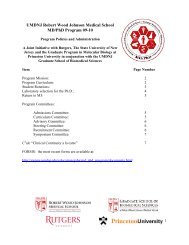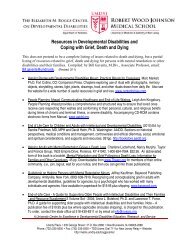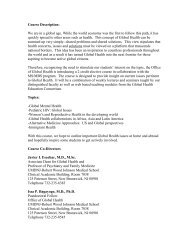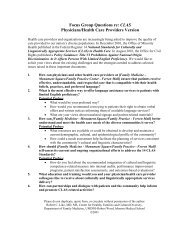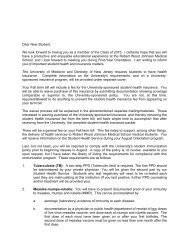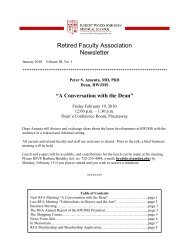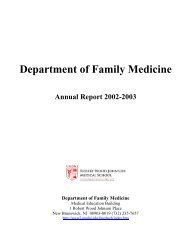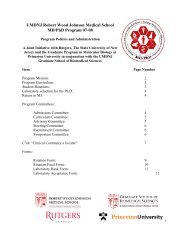Robert Wood Johnson Medicine • Spring 2011 • Population Science
Robert Wood Johnson Medicine • Spring 2011 • Population Science
Robert Wood Johnson Medicine • Spring 2011 • Population Science
You also want an ePaper? Increase the reach of your titles
YUMPU automatically turns print PDFs into web optimized ePapers that Google loves.
The Winik Family<br />
H ealthy and happy today, twins Claire and Charlie<br />
Winik and their mother, Laura, had extraordinary care from<br />
a village of specialists at RWJMS and RWJUH. Seen here<br />
with her husband, Adam, and the twins, Mrs. Winik received<br />
her obstetric care from the maternal-fetal medicine team.<br />
A pre-existing brain shunt failed in her 35th week, necessitating<br />
emergency care and specialized surgery. Within days,<br />
Mrs. Winik developed pre-eclampsia and required a cesarean<br />
section. The ICU team saw her through to complete recovery,<br />
while the twins were cared for in the NICU.<br />
MFM specialists can treat most of these conditions without<br />
sending the mother to another specialist, for example a cardiologist,<br />
endocrinologist, or neurologist. As high-risk<br />
obstetricians, Dr. Rosen and his team can generally make<br />
necessary adjustments or substitutions in medications that<br />
control heart disease, hypertension, diabetes, or seizures.<br />
The health of mother and fetus is tracked at the center<br />
through regular diagnostic screening and testing that<br />
includes additional ultrasound — with both three- and<br />
four-dimensional imaging — amniocentesis and chorionic<br />
villus sampling for Down syndrome and trisomy 18, fetal<br />
blood sampling, and fetal echocardiography.<br />
Babies in utero are not immune to infection. The virus<br />
that causes fifth disease might give the mother only a mild<br />
rash, but it can cause serious problems for the fetus, including<br />
anemia or birth defects. Fetal testing can reveal the<br />
presence of infection, providing the perinatal team with the<br />
information it needs to treat the baby in utero or to plan<br />
JOHN EMERSON<br />
treatment that would start immediately after delivery.<br />
“We can also perform transfusions on the baby — through<br />
the umbilical cord — while she or he is still in utero,” says Dr.<br />
Rosen. Recalling a recent complex case that was referred to<br />
MFM from another regional perinatal center, he says, “The<br />
mother was so grateful that she named her baby after me and<br />
the sonographer who assisted during the procedures.”<br />
Dr. Rosen pauses, then adds: “Actually, I got the middle<br />
name; the sonographer got the first name.”<br />
High-Risk Deliveries Increase<br />
the Need for Specialized Anesthesia<br />
Specialized anesthesia plays a critical role in the outcome<br />
of high-risk deliveries, says Shaul Cohen, MD,<br />
professor of anesthesiology. The increase in diabetes and<br />
obesity has led to a rise in high-risk deliveries, says Dr.<br />
Cohen. In a severely overweight patient, it can be difficult<br />
to safely secure the airway and to successfully bypass the<br />
vocal cords. Dr. Cohen prefers to use a epidural-spinal split,<br />
a combined approach that avoids the airway problem, may<br />
enable a vaginal birth and produce a healthier baby, and<br />
gets the patient back on her feet sooner. Controlling pain<br />
can be especially important for women with cardiovascular<br />
disease, he adds, because pain causes a rise in heart rate and<br />
blood pressure.<br />
With a “walking epidural,” a patient-controlled form of<br />
pain management, a woman administers analgesics to herself<br />
locally during the post-partum period, when and as she<br />
needs it. The epidural eliminates weakness in the lower<br />
extremities, says Dr. Cohen, so she can move about comfortably<br />
on her own, and it lowers the risk of thrombosis<br />
(blood clot formation) and pneumonia.<br />
Ensuring a High and<br />
Inclusive Standard of Care<br />
P<br />
regnant women who are HIV-positive receive specialized<br />
treatment in the <strong>Robert</strong> <strong>Wood</strong> <strong>Johnson</strong><br />
AIDS Program (RWJAP), a division of the Department of<br />
Pediatrics. During their pregnancy, they are seen by MFM<br />
<strong>Robert</strong> <strong>Wood</strong> <strong>Johnson</strong> ■ MEDICINE 21





